
NPS / S. Schaller 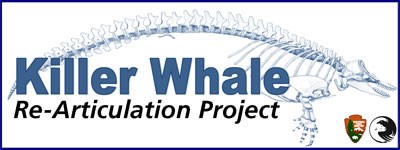
In February 2014, a 12 ft. juvenile killer whale skeleton was put on display in the Gustavus Public Library.This female specimen was found dead in Glacier Bay in 2005. Her entire skeleton was collected and preserved for educational purposes. The park partnered with well-known Articulation Specialist, Lee Post, the Gustavus Public Library, the Gustavus School, and Alaska Geographic to complete the articulation and installation. The Gustavus School staff and students were thrilled to host the articulation project on site. They had the opportunity to watch Lee's daily progress and take part in educational programming. The high school students painted the cast teeth in the display. To see this rare and unique specimen, be sure to stop by the Gustavus Public Library during your visit to Glacier Bay. You can view the whale six days a week, Monday through Saturday. Please call 697-2350 for daily hours of operation. 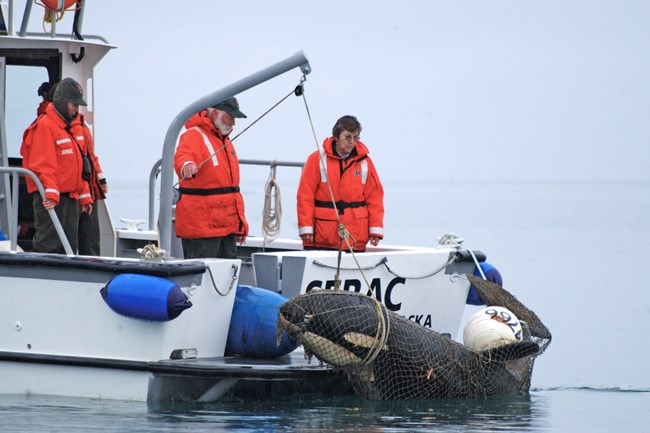
NPS Photo / J. Neilson Part 1: DiscoveryA small, juvenile female killer whale, approximately 12 ft. long and 5 years old, was found dead on Young Island in Glacier Bay on August 26th, 2005. She weighed approximately 600-800 lbs. Park personnel towed the dead calf to Bartlett Cove to await further examination by veterinarian Dr. Pam Tuomi from the Alaska Sea Life Center (Seward, AK). The necropsy performed on August 28th determined the whale died of pneumonia and malnutrition as a result of injuries sustained from swallowing a halibut circle hook. Who was this little killer whale? As far as we know, this calf had not been previously identified, but she was presumed to be a resident type killer whale from AF or AG pod. A large group of resident killer whales had been seen and acoustically heard in the area before and after this stranding. During a Grand Opening Celebration in February 2014, Tlingit elders named the whale "Keet'k," which means "little whale." 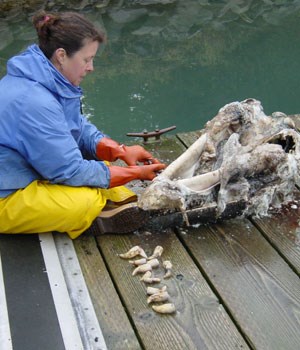
NPS Photo Part 2: Cleaning and PreparationAfter recovering the whale from the beach, the next step was cleaning and prepping the skeleton for display. The Bones and TeethA few days after the necropsy, the entire skeleton was flensed and prepared for cleaning. The bones were carefully separated into bundles and put into either crab pots or nets and submerged in the ocean for almost two months. Over the next several weeks park staff carefully monitored the bones, including a large, plastic trash can which held the skull. After soaking for almost a month, all forty-eight teeth were loose enough to be removed without causing damage to the teeth or jawbones. They were given a final cleaning and stored in olive oil to prevent cracking. After a few more weeks of soaking, the entire skeleton was removed from the ocean and moved to compost at the local landfill for further cleaning. At the landfill, compost dirt quickly decomposed any remaining soft organic matter on the skeleton, allowing future cleaning to be done using stronger cleaning processes. 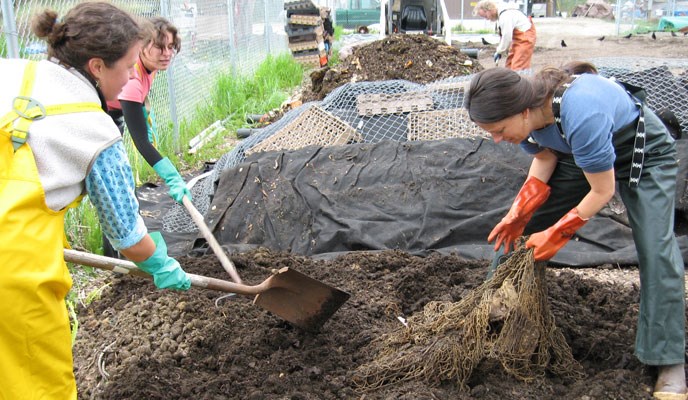
NPS Photo Journal entry - October 19th, 2005: "The orca has been relocated to the town landfill! First, Chris pulled all the teeth, which was not her favorite chore and reminds her never to be an oral surgeon. The left teeth came out much more easily than the right side. The two spinal column sections were transferred from crab pots to nets. The head was also put in a net. The other three nets, plus the newly netted sections, were transferred to the Gustavus landfill. First, a six to twelve inch layer of hot wood chips was laid down to improve drainage. Then the bone bags were arranged in a row. And finally, a three to six inch layer of horse manure was laid down over the bone bags followed by another six inches of wood chips. The whole pile was covered in a black composting fabric and chain link fencing to keep the birds away." In the spring, the skeleton was excavated and brought back to Bartlett Cove. Throughout the summer, park staff and volunteers continued cleaning until the bones were ready to go into dry storage. From September 2006 until September 2012, the bones and teeth were kept in a large storage container (the "bone cache") to await the next step - articulation and installation. 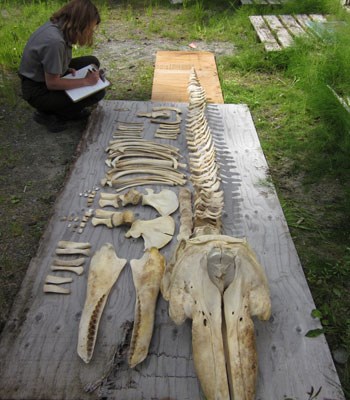
NPS Staff Numbers and WeightsIn the summer of 2012, park staff inventoried and evaluated the condition of the skeleton in preparation for articulation and final display. Although the bones were in near pristine condition, several presented with light oil staining. It would take almost a year of intermittent cleaning with a weak (3%) hydrogen peroxide solution to get the bones ready for articulation. Hydrogen peroxide was used to homogenize the color of the bones. During a soak, each bone was carefully monitored to insure the minimal amount of peroxide exposure for the desired result. The skull was the largest bone and the most problematic. A large, plastic wheelbarrow was borrowed from the back country office to accommodate its large size. Bottles of water were used to displace the peroxide so the skull would be more evenly immersed. It took several months of careful monitoring and manipulation before the skull was considered clean After all the bones were cleaned to satisfaction, the skeleton was weighed and put back into storage. It weighed a mere 50 pounds. Now that all 50 pounds of whale bones were clean and accounted for, the next step: articulating the bones into their display position! 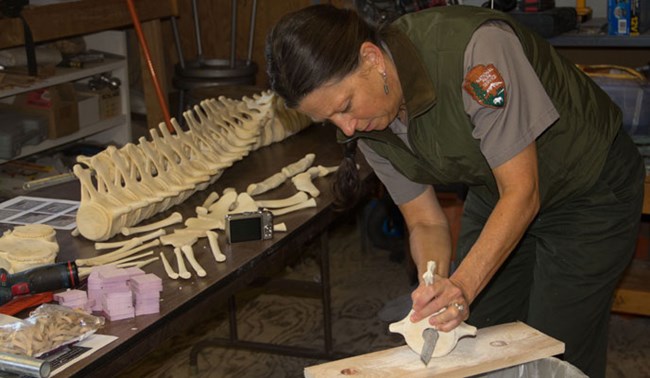
NPS Photo Part 3: ArticulationThe articulation of Keet'k was the highlight of the entire nine year project. It took place in February, in a small, heated, workshop beside the Gustavus K-12 school. The location provided convenient access for the community and afforded the students and staff daily visits to the shop. Most of the work was done by Articulation Specialist, Lee Post, park staff, and a handful of school and community volunteers. The high school students got involved by painting the 48 cast teeth and matching up the growth plates to their corresponding vertebrae. Because Keet'k was such a young whale the growth plates had not yet fused to the vertebrae and had to be glued in place before the vertebrae could go together. It took only 10 days to complete the articulation. 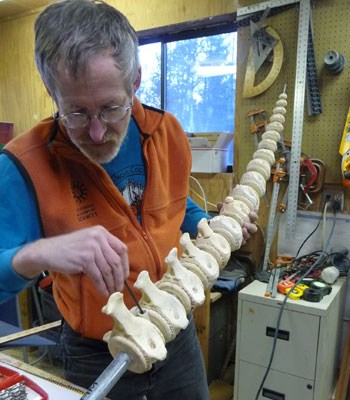
NPS Photo The Backbone and SkullWhen building anything, including a whale, you start out with a foundation. The foundation for Keet'k was a seventy-five inch long, 3/4" schedule-40 steel pipe. Holes were drilled into twenty-eight vertebrae and threaded onto the pipe. Next, seventeen tail vertebrae were strung on decreasing sizes of all-thread rod pieces and welded together. The two pipes were joined and locked into place. Small foam doughnuts were made and placed in between each vertebra to act as spacing. Silicone caulk was then added to hide the metalwork and lock the bones into place. The skull and cervical vertebrae were supported by a fabricated skull cradle which was then inserted into the front end of the large hollow pipe and locked into place. Hanging brackets were welded onto the pipes so that none of the bones were directly used to support the skeleton.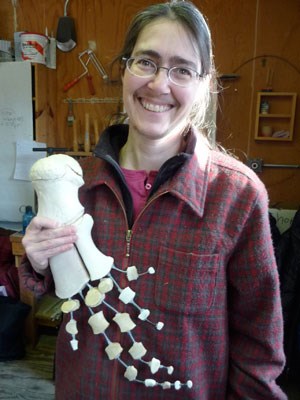
NPS Photo The FlippersReconstructing the flippers was the most time consuming and labor intensive part of the articulation. It took an entire ten days to drill holes, fasten wires, and add cartilage. A very eager volunteer worked several hours almost daily to help with the process. She served as an apprentice for the first two days as Lee explained and demonstrated the process from start to finish. He used an x-ray of a flipper from a killer whale he had previously known to help guide the placement of the bones and shape of each finger. Once the bones were in place, silicone caulk was used to fill in the gaps and give the flippers their distinctive form. Working with caulk was a sticky job, but Lee introduced the team to bubble soap! By dipping their fingers into the soap before touching the caulk, it allowed them to smooth and mold it to a beautiful finish. It was a form of art. 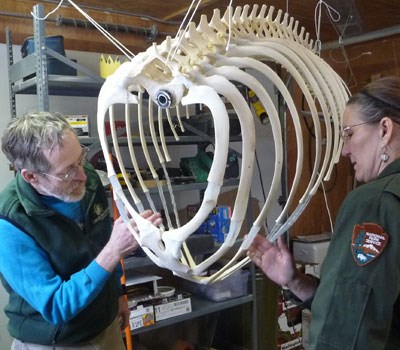
NPS Photo The RibsIt took several long days and evenings before the ribs were secure and ready for cartilage. The rib cage was articulated using small pins that joined each rib to its corresponding vertebra. Once all the ribs were stable, the bones and the ribs of the sternum were put together and carefully joined to the upper ribs to form the rib cage. It took many layers of silicone caulk to cover the exposed wires and create the finished look of cartilage. Because Keet'k was such a small whale, some of her bones had not yet grown to their full size requiring Lee to use quite a bit of caulk to fill in the spaces. 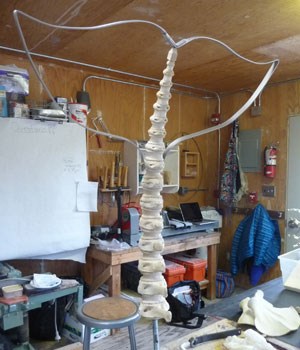
NPS Photo The TailLee created a metal tail outline to preserve the space at end of the tail vertebrae. It was modeled from a killer whale photo and scaled to the size of Keet'k's flukes. Because there are no bones in a whale's tail, when a skeleton is articulated there is nothing to suggest a tail was ever there. Lee stated that by highlighting that part of Keet'k's anatomy, it would help visitors identify her as a whale instead of a dinosaur - a common mistake. Lee received lots of positive input from park staff and the community and decided to add his metal tail flukes. 
NPS Photo Articulation ExpertIn February 2014, the park hired well-known Articulation Specialist, Lee Post from Homer, Alaska, to reassemble the bones into a skeletal display. Lee came highly recommended and had previously articulated twenty whale skeletons of various species, four of them killer whales. According to Lee, Glacier Bay's killer whale calf was rare among specimens due to its young age (5 to 6 years), size (11 feet, 9 inches), and pristine condition of the bones. He stated that were were fewer than eight complete killer whale skeletons on display in the United States. During the articulation phase, Lee worked in a 10' x 16' shop located just behind the local K-12 Gustavus School. It was heated with a small oil stove, but warmed by the laughter and curiosity of dozens of school children as they came in daily to check out his progress. Park rangers facilitated classroom visits and hosted volunteer hours every afternoon. Even with only a short window for articulation, Lee always paused to answer a question or listen to a story. He came prepared with all his tools knowing Gustavus had no road access to or from any other town for materials or supplies. Several boxes of nuts, bolts, screws, and fasteners were mailed to the park making good use of flat rate priority mail! 
NPS Photo Part 4: InstallationOn February 14th, Lee finished the whale, cleaned up the shop, packed his gear, and gave the go ahead to move the whale to the library. Lee and a small crew of park staff hand carried the articulated whale approximately 30 yards from the shop to the library. Step-by-step, they traveled slowly over the frozen, hard ground until they reached the warmth and light of the library. With music playing in the background, many community volunteers showed up to lend a hand. In a little over six hours, Keet'k was suspended a perfect little space and once again looks like a happy swimmer in her new home!
NPS Photo Part 5: Final Display!Following the articulation and installation of the killer whale display, it was time to commemorate this new display with a special public event. Grand OpeningAn Open House was held on February 25th to celebrate the culmination of the nine year project. Glacier Bay's interpretive division facilitated an evening of orca-themed events and presentations and welcomed honored guests from the Hoonah Indian Association to perform a Tlingit blessing. Tlingit elders performed a blessing ceremony and gave the whale her name, "Keet'k", which means, "little killer whale", to commemorate the return of her Spirit. Today, we are honored to see Keet'k 'swimming' among the library's rafters. The beautiful display would not have been possible without the support and hard work of many. Partners included: Alaska Geographic, Gustavus School, Gustavus Public Library, Lee Post, and over sixty Gustavus community volunteers and friends. 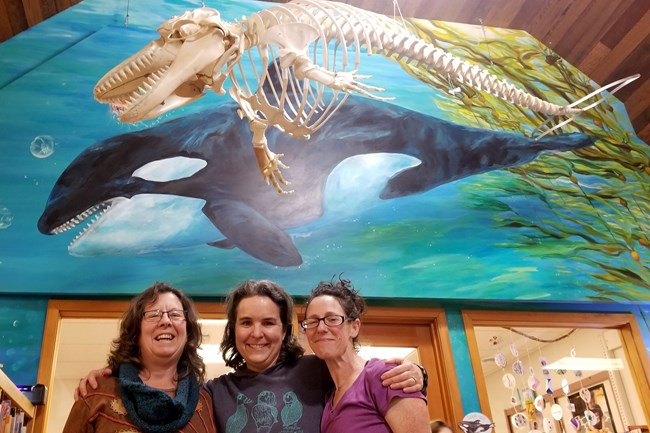
NPS Photo New MuralIn 2023, an effort was undertaken to paint a mural of Keet'k as she might have appeared swimming in her natural landscape. This mural was specifically designed to match the shape of the skeleton's articulated display. The Gustavus Library hired local artist Jess Mulligan to paint this beautiful mural, with funding help from the City of Gustavus thanks to the memorial fund for Brian Waverly, generously donated by his widow Alice Waverly. Glacier Bay National Park and Preserve is beyond thankful to partner with our local community of Gustavus' public library for this project, and we look forward to collaborating with the library for public and private events, educational opportunities, and more. 
NPS Photo |
Last updated: September 30, 2024
